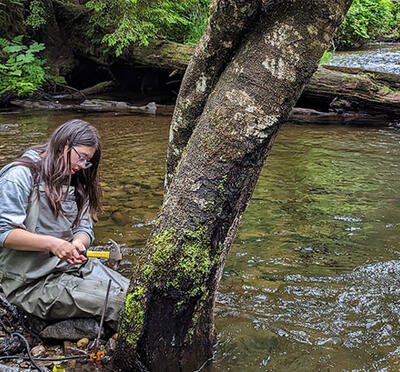Three MIME faculty have achieved early-career benchmarks by earning prestigious and competitive research awards from the National Science Foundation (NSF) and the Office of Naval Research (ONR). This is the second year in a row that the school can boast three winners in a single year, and it now lists 14 of its 50 research faculty as past winners. Altogether, research funding for this year’s awards totals more than $1.5 million.
“We’ve seen such impressive growth in recent years, and the recognition of our newer faculty members shows that MIME is poised to remain in a strong position on the national and international stage for years to come,” says School Head Harriet Nembhard.
Two professors, Ross Hatton, assistant professor of robotics and mechanical engineering, and Julie Tucker, assistant professor of mechanical engineering, received the CAREER award, NSF's most prestigious honor in support of early-career faculty who exemplify the role of teacher-scholars through research, education and the integration of research and education to forward the mission of their organization.
The third professor, Geoff Hollinger, assistant professor of mechanical engineering, won an ONR Young Investigators Award, which supports candidates from a pool of college and university faculty who have obtained tenure-track positions within the past five years. This year’s 33 winners were selected from over 360 highly qualified applicants.
Hatton’s research interests lie at the intersection of robotics, mechanics, and biology. He will receive a $500,000 CAREER award for his project titled Geometric Understanding of Locomotion.
The project will create a rigorous mathematical framework for analysis of the ways in which animals propel themselves. The goal of the work is to design bio-inspired robots that approach and surpass the capabilities of natural systems.
“Animals and robots move through the world by pushing against their environments,” explains Hatton. “Even though the physics of these interactions vary with differences in anatomy, scale, and surrounding material, there exist fundamental principles for how animals and robots can best exploit the resulting forces.” His research seeks to identify and concisely express these principles.
The CAREER award will support his investigation of new classes of systems — e.g. snakes with scales that prevent backwards sliding. The resulting framework for studying locomotion will contribute both to the design of robots able to travel in new and hazardous environments, and to our understanding of how animals interact with their ecosystem.
Tucker’s research focuses on thermal/irradiation stability of structural alloys used in nuclear power systems and leverages both modeling and experimental techniques.
Her CAREER award will provide $522,000 to study alloys kept in service for many years at temperatures from 200-500 degrees Celsius – a range where temperature effects are very low in the short run but become significant over time. Knowledge of how alloys behave in this middle range of temperatures are essential in many important industries, including the aerospace, energy production and petrochemical industries. As the materials degrade, their ability to perform as designed is compromised, which can lead to safety hazards. But because degradation can take decades, laboratory studies are impractical because they could last years. Tucker proposes to use radiation to accelerate the alloy degradation process, thus making laboratory evaluation feasible.
Tucker’s project is also designed to act as a vehicle for both recruiting and retaining a future generation of engineers and scientists from under-represented groups by integrating with two mentoring programs that bring Oregon high school, undergraduate and graduate students together in the lab.
She sums up both her research and teaching philosophy in two succinct sentences: “I bring real life examples into the classroom and lab so my students see why this might matter. And I try to create a supportive, caring environment in which students can thrive.”
Hollinger conducts fundamental research in the quickly growing area of robotic systems. Among the major goals of his Robotic Decision Making Laboratory is formulating more effective ways for networks of autonomous robotic systems to work together to plan and coordinate their actions and learn how to make optimal decisions during complex data-gathering missions.
He was awarded $510,000 for his proposal, Information-Aware Decision Making in Teams of Autonomous Vehicles and Humans.
“Teamwork requires consulting with each other for assistance,” explains Hollinger. “In the future, this assistance may come from autonomous robots/vehicles, mission commanders, and humans deployed in the field. However, determining when to ask for assistance and what type of assistance is needed (e.g., information, guidance, or clarification) is a challenge.”
With the award, Hollinger will develop new decision making algorithms that reason intelligently about the effects of observations on mission objectives. The impact of this project will be significantly reduced communication, decreased computation, and optimized performance in naval-relevant autonomous systems.
For more information, visit the NSF CAREER and Young Investigator awards websites.




